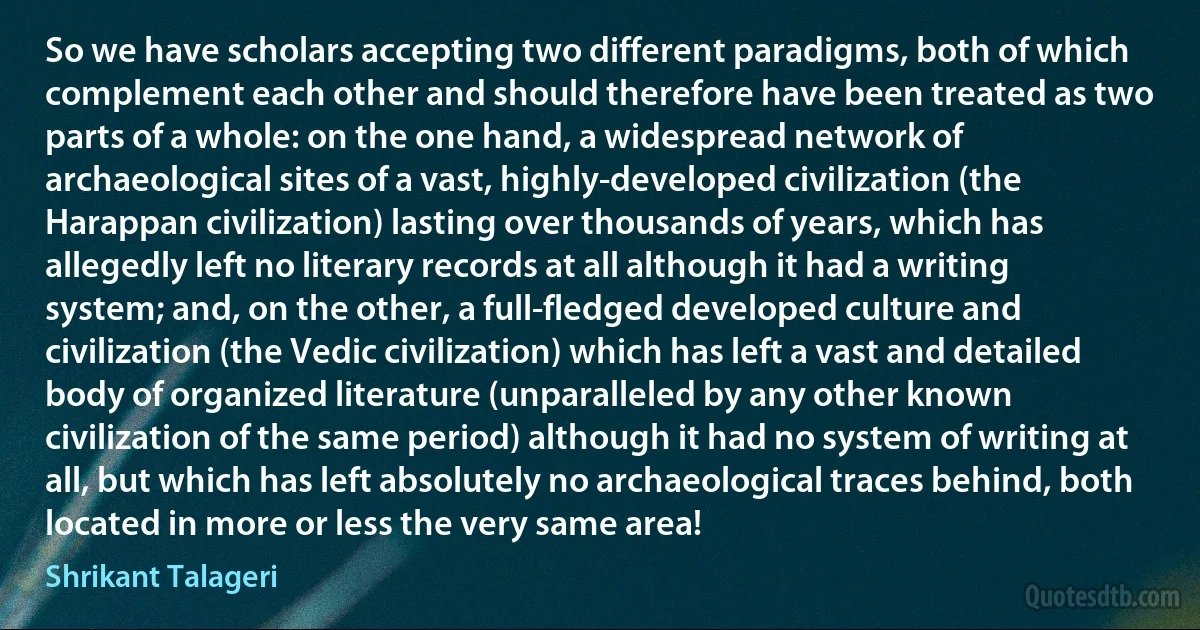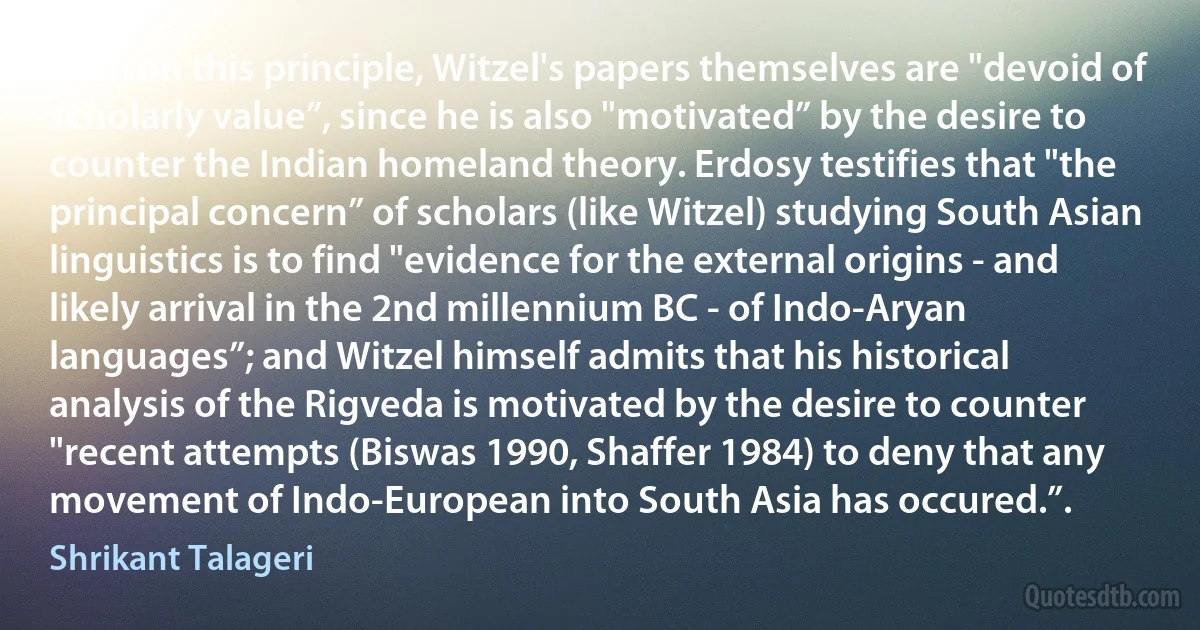Shrikant Talageri quotes - page 2
Sanskrit has many words for the horse: aśva, arvant or arvvā, haya, vājin, sapti, turanga, kilvī, pracelaka and gho ṭ aka, to name the most prominent among them. And yet, the Dravidian languages show no trace of having borrowed any of these words; they have their own words kudirai, parī and mā [...] The Santali and Mundari languages, however, have preserved the original Kol- Munda word sādom. Not only has no linguist ever claimed that the Dravidian and Kol-Munda words for horse‘ are borrowed from 'Aryan‘ words, but in fact some linguists have even sought to establish that Sanskrit gho ṭ aka, from which all modern Indo-Aryan words are derived, is borrowed from the Kol-Munda languages.

Shrikant Talageri
Even the strongest advocate of the Aryan invasion theory cannot, in all honesty, point out any specific spot outside India to which the origin of any, simply any, aspect of Hinduism could be attributed. Even if, for the purpose of this chapter, it is presumed that the 'Aryans' came from outside India, and that they imposed the Hindu religion on local inhabitants (two questions which will be dealt with subsequently in this book), it will have to be admitted that there is no trace of any foreign connections in Hinduism, much less the consciousness, of any such connections, among Hindus-and least of all, any foreign loyalties, associable with such foreign connections".

Shrikant Talageri
"The modern Indo-Aryan languages are not descendants of the Rigvedic dialects, but of other dialects which were contemporaneous with the Rigvedic dialects, but which belonged to a different section of Indo-European speech (the Inner Indo-European section). The Vedic dialects died away in the course of time, and their speech area [....] was taken over by the Inner Indo-European dialects. But long before they died away, the Vedic dialects had set in motion a powerful wave of a cult movement which covered the entire nation in its sweep. This Vedic cult also finally gave way to the local pan-Indian religion of the Inner-Indo-Europeans and Dravidian-language speakers, but continued to remain in force as the elite layer of this pan-Indian religion” (TALAGERI 1993a:230).

Shrikant Talageri
When the Ramayana was being shown as a serial on TV, Leftist and progressive artists, led by doughty warriors like A.K. Hangal and Dina Pathak, organized a march in Bombay to protest against this "communal" act of Doordarshan (Rama being a pre-Islamic Indian hero, any serial on him would obviously be a "communal" one). Addressing a rally at the conclusion of the march, Dina Pathak bitterly castigated Doordarshan for showing another "communal" item on its network-a report of the archaeological discovery, by Dr. S.R. Rao, of the remains of ancient Dwarka, under the sea, off the coast of Gujarat (Dwarka, having sunk under the sea long before the birth of Islam, any report on it would obviously be a "communal" one). Need we say more?" (TALAGERI 1993:32-34).

Shrikant Talageri
On the other hand, northern India is the only place where place-names and river-names are Indo-European right from the period of the Rigveda (a text which Max Müller refers to as "the first word spoken by the Aryan man”) with no traces of any alleged earlier non-Indo-European names.

Shrikant Talageri
How does Witzel get a chronological order so completely different from our own (which is VI, III, VII, IV, II, V, VIII)?.. The answer is very simple: although Witzel postulates the establishment of a chronological grid "on the strength of a few pedigrees of chiefs and poets available from the hymns,” he does not establish any such grid.

Shrikant Talageri
Witzel takes up two verses which clearly refer to eastern rivers, misinterprets them as references to the Indus, further misinterprets them as references to crossings of the Indus river from west to east, and then reconstructs an entire saga of the immigration of the Rigvedic Aryans into India on the basis of these misinterpretations. He even pinpoints the exact area "eastern Iran” from which specific immigrants, "the Bharatas and VasiSTha”110, led this historical exodus across the Indus.... Is "gross misrepresentation” an adequate word to describe this whole exercise?... His sole criterion in preparing a chronological arrangement is his own geographical grid prepared on the basis of deliberate misinterpretations of Rigvedic geography.

Shrikant Talageri
(Witzel's) review should logically have consisted of two parts: 1. A rebuttal of chapter 9 of my book (my critique of WITZEL 1995a, 1995b)... This chapter of my book shows Professor Witzel inventing evidence, suppressing inconvenient data, following an inconsistent methodology, retrofitting data into pre-conceived notions, contradicting himself again and again, and using misleading language. 2. A review of my own theory and conclusions.

Shrikant Talageri
In general the only criterion Witzel has in accepting any analysis is that "the results should be close to those found in Witzel 1995, 1999” (§7) – except, of course, where Witzel has reason to believe that something "found in Witzel 1995, 1999” (or any other year) is now inconvenient to his position and fits in with his "opponent's” position, in which case "results should be close to those convenient to Witzel today”!

Shrikant Talageri
To begin with...: "a) Each Mandala (or upam). contains hymns ascribed to the descendants of earlier mandalas (or upam.s), or the ancestors of later mandalas (or upam.s). b) Each Mandala (or upam.) contains references to composers from earlier or contemporaneous mandalas (or upam.s)” And "in not one of these respects do we find the allegedly ‘concocted' Anukramani ascriptions .... differing from the allegedly ‘original' ascriptions”.

Shrikant Talageri
Here, again, a case of what Max Muller called "special pleading”: now Witzel claims not only to be able to identify "non-Indoaryan” loanwords in Vedic, he can also identify the exact regions from which these "loanwords” were borrowed: we have Punjab loan words, U.P. loan words, Bactria-Margiana loan words...! Witzel knows, with scientific exactitude that "loanwords”, from imaginary "substrate languages”, which are found in both Vedic and Iranian are definitely from Central Asia, and not from the Punjab or U.P., and, equally, that "loanwords” found only in Vedic are from the Punjab or U.P. – not, of course, because his theory suggests these locations, but because he has found actual inscriptions from pre-RV eras, in one or more non-Indo-Iranian languages, from the respective areas, where these words are actually recorded!

Shrikant Talageri
It is clear, from his complete dependence on abuse, innuendo, misleading statements and lies in his "review article”, that Witzel has no logical argument to offer against my theory, analysis and conclusions. .... Far from launching a crusade against 19th century colonialism (Witzel's review article is a typical specimen of how a crusading article sounds), I in fact point out at some length why I cannot subscribe to any view which holds the 19th century "colonial” scholars more than superficially guilty for the AIT or its present-day ramifications.

Shrikant Talageri
At another point, Witzel writes: "Talageri also views as interpolations the vAlakhilya hymns of 8.49-59 (although these are, in fact, included and analyzed in zAkalya's padapATha)” (§1). Is it, to begin with, Witzel's contention that if a hymn or verse is "included and analyzed in Shakalya's padapatha”, it automatically means that the hymn or verse in question is not an interpolation? All scholars are in agreement that the Valakhilya hymns are later than the other hymns in Mandala 8, and were inserted later into the middle of the Mandala in the Shakalya Samhita.

Shrikant Talageri
Indian culture being the greatest and richest is not a narrow or chauvinistic idea; it is a demonstrable fact. It would be chauvinistic if it acquired an imperialist tinge: that other cultures are inferior and Indian culture must dominate over or replace them. In fact, I am opposed to even internal cultural imperialism. The idea that Vedic or Sanskrit culture represents Indian culture and that other cultures within India are its subcultures and must be incorporated into it, is wrong.... all other cultures native to this land: the culture of the Andaman islanders, the Nagas, the Mundas, the tribes of Arunachal Pradesh, etc. are all Indian in their own right. They don't have to be – and should not be – Sanskritised to make them Indian.

Shrikant Talageri
Witzel‘s location of the Sarasvatī in Book 2 in Afghanistan is not an honest one: he does it only because he wants a Rigvedic Book which refers only to western rivers, in order to show the Vedic Aryans ―fighting their way through the NW mountain passes in their alleged movement from west to east, and Book 2 is his only option, since the name of only this one river is mentioned in the whole of this Book, and it is a name which can be manipulated from east to west by creating a dual entity (thanks to the existence of a Sarasvatī, the Avestan Harahvaiti, in Afghanistan).

Shrikant Talageri
In my earlier book on the Rigveda, I examined the Rigvedic data in detail, and showed that the chronological order of the ten Books of the RV is: 6,3,7,4,2,5,8,9,10, with different parts of Book 1 covering the periods of all but the three earliest Books. I also showed in systematic detail that Family Books 6, 3 and 7 belong to the Early period, Family Books 4 and 2 to the Middle period, and the rest (Book 5 among the Family Books, and all the other, ie. non-family, Books, 8, 9 and 10, and most of Book 1) belong to the Late period.

Shrikant Talageri
Witzel frequently refers to the references to armaka, "ruins", in the RV, as evidence that the RV is later to the desolation of the Indus cities... In any case, the word armaka, so frequently referred to in the post-RV literature, is found in the RV only in one late hymn in a Late Book: in I.133.3. The Early and Middle Books, and even much of the Late Books, are totally ignorant about these ruins.

Shrikant Talageri
The Harappan civilization is situated deep within Indo-European ("Indo-Aryan") territory. The closest non-Indo-European families are at some distance:... There is no linguistic, archaeological or anthropological evidence indicating that the Harappan civilization was supplanted by a linguistically different race of people: on the contrary, archaeologists and anthropologists insist on continuity in the anthropological situation from Harappan times well into post- Vedic times. In these circumstances, the Harappan civilization should have been assumed to be Indo-European until proved otherwise. However, in gross violation of normal scholarly practice, it has been assumed to be non-Indo-European.

Shrikant Talageri



